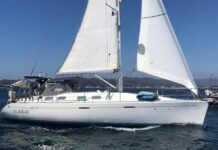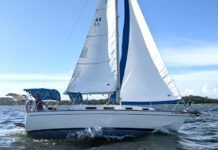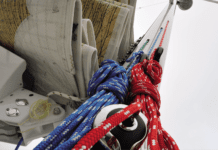

There are approximately 32,000 species of fish, including 60 to 70 species of flying fish. Although our interactions with these flying wonders may be limited to deck-clearing duties on the sunrise shift or a thwack in the face during the dog watch, renowned naturalist Steve N.G. Howell dedicated several-hundred hours perched on the bows of boats in the sweltering tropics to capture the unique images featured in the informative The Amazing World of Flyingfish. With 90 color photos shot mainly in the western tropical Pacific and in the Gulf Stream near Cape Hatteras (using a Canon 20D), Flyingfish differentiates two-winged and four-winged flyingfish from fish that merely jump; it outlines species, habitats, and sizes, analyzes flight methods and colors, and offers tools on identifying these butterflies on the water. Howell-author of a half-dozen books on birds, including Hummingbirds of North America and A Guide to the Birds of Mexico and Northern Central America-has been affiliated with the Point Reyes Bird Observatory for 20 years and is currently a senior birding tour leader for WINGS. Howells Flyingfish also addresses the environmental challenges our oceans face and encourages readers to promote environmental awareness and protection. Flyingfish is a good read for information hounds and marine biology buffs.
In the introduction to Practical Sailor Technical Editor Ralph Naranjos The Art of Seamanship: Evolving Skills, Exploring Oceans, and Handling Wind, Waves, and Weather, Naranjo proposes that good seamanship calls for more than the flashy, state-of-the-art science and technology found onboard many boats today. The art of seamanship involves skill acquisition, vessel preparation, and crew training, he says. Naranjo, who voyaged around the world with his family, is a racing sailor turned longtime cruiser-not to mention an adjunct lecturer at the Annapolis School of Seamanship and former Vanderstar Chair at the U.S. Naval Academy. He focuses on these key components of seamanship in his long-anticipated, 500-page resource book.
The well-organized chapters address vessel awareness and competency topics such as planning, boat handling, anchoring, sail handling, and navigation, along with the development of the psychological characteristics of good seamanship such as mental acuity, ingenuity, leadership, and the ability to deal confidently and swiftly with the unexpected. The Art of Seamanship is a worthy addition to any cruisers library.
The prevalent use of GPS and electronic navigation equipment aboard ocean-going vessels threatens to turn the use of the sextant into a lost art. David Barrie, in his book Sextant: A Young Mans Daring Sea Voyage and the Men Who Mapped the Worlds Oceans, notes that although the golden age of celestial navigation has come to an end, the sextant was an indispensable navigational tool for 200 years. Barrie recounts stories of extraordinary mariners who put the sextant to use exploring and mapping the world: Captain Cook, Bougainville, La Prouse, Vancouver, Flinders, and FitzRoy. The book includes fascinating historic accounts of the desperate, heroic voyages of William Bligh, Joshua Slocum, and Frank Worsley (captain on Ernest Shackletons Trans-Antarctic expedition). Barrie weaves his own journal entries from his first Atlantic crossing as a wide-eyed 19 year old into the fabric of these historic voyages, creating a crisp, graceful story infused with a sense of wonder and discovery.
Its been 100 years since Sir Ernest Shackletons Endurance set sail from Great Britain on the Imperial Trans-Antarctica Expedition, and the interest in inspiring adventurer has not waned. Dozens of books have been published, along with films, articles, and lectures focusing on the polar explorer, his leadership skills, and his courageous exploits. Michael Smith, an author and journalist who specializes in the history of polar exploration, has written the first full Ernest Shackleton biography to be released within the last 30 years. Shackleton: By Endurance We Conquer draws on Smiths extensive research to bring to life this charismatic explorer who pioneered a path to the South Pole over a century ago, and who became a dominant figure in Antarctic discovery.
The little ship Victura became part of the Kennedy family in 1932, and for five decades, it remained the brightest star in the ever-growing Kennedy fleet. Pictures of the vast Kennedy clan sailing off Hyannis Port, Mass., secured the Kennedy family brand in the media-adventurous, wholesome, vigorous, all in the same boat. In Victura: The Kennedys, a Sailboat, and the Sea, author James W. Graham proposes that sailing defined the family who defined America. Victura tells the stories of Joe Jr., Jack, Bobby, and Ted, along with their sisters, wives, political offices, and children. It tacks through their glamorous successes and heartbreaking defeats, always with the sea as a background. Opening with Tennyson and closing with F. Scott Fitzgerald, Grahams poetic nod to Victura and the Kennedys-embracing all of Camelots triumphs and tragedies-is a love story of life.
In the elegantly written Sea Trials: A Lone Sailors Race Toward Home, author Peter J. Bourke tells of his 2009 OSTAR (Original Single-handed Trans-Atlantic Race) experience, following the sudden death of his young wife. His wifes death left him adrift as he struggled with sadness, raising his two young children, and continuing a finance career. His friends thought he was crazy to buy the Outbound 44 Rubicon with no formal sail training or sail experience, but Bourke found that sailing kept his life in balance. Once his children were out of high school, he entered the OSTAR. His solo sail of the Atlantic, leaving one shore behind and safely coming home again, is an uplifting story of rebirth, inspiring readers to take risks, reach for dreams, and set out for the far shore.
In Plotting the Course: Life Lessons from the Sport of Sailing, author Rick Arneson outlines essential lessons for personal and professional achievement, drawn from the world of competitive sailing. Chapters on inspiration, planning, performing and learning take the reader through the framework of life as if it were sailboat racing. The book includes sage and sometimes entertaining advice on such subjects as negotiating interference and obstacles; focus under stress; and the importance of knowing the game, the language, the rules, and the players.
Not for the faint of heart-but not to be missed by anyone with an interest in the art of navigation-The Marine Chronometer: Its History and Development, written by Ruppert T. Gould, is a 500-page second edition to Goulds original tome published in 1923. This is the seminal text on the development of the marine chronometer, comprehensively outlining the earliest attempts to measure longitude. The book includes Goulds annotations, sketches, and manuscript notes on the original text with an updated second edition in mind. It features 65 images from Goulds collection of chronometers. Better suited for armchair reading than onboard entertainment due to its size and weight, this impressive volume of information is a rare find and a true gem.
If your travels take you to distance lands and boatyards far from the safety of the English language, never fear: The Illustrated Boat Dictionary in 9 Languages can guide you and your new deckhand through the seas of translation. Diagrammed, color illustrations of race courses, running rigging, points of sail, and ships systems make the switch from English to French, German, Dutch, Danish, Spanish, Italian, Portuguese, and Greek as easy as naviguer sous le vent. This lightweight book would make a nice addition to the ships library for anyone traveling to foreign shores.
Any damn fool can circumnavigate the world sober. It takes a really good sailor to do it drunk, Sir Francis Chichester is quoted as saying in The Little Blue Book of Sailing Wisdom, edited by Stephen Brennan. This small collection of quotes includes quips on the sea, sailors, ships, wind, weather, and the philosophical nautical mind, with gems like Chichesters and quotes from the likes of Hemmingway, Shakespeare, John Mayesfield, and Jack Kerouac. Whether you browse through the history, romance, nature, and lore from your tropical cockpit, or consume the mystery, romance, travel-log, and love poems from your armchair waiting for springs thaw, Skyhorses inspirational collection will certainly remind you of your call to the sea.








































